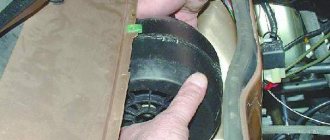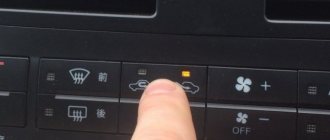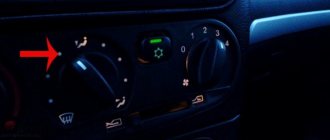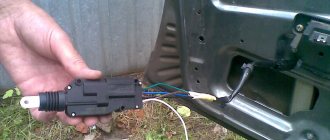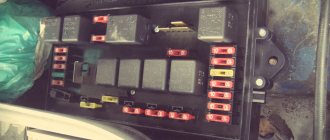The Lada Priora is in many ways similar to its progenitor, the VAZ of the tenth family, including the design of the heater. The manufacturer decided to leave the operating principle of the stove, replacing only some elements with new ones. At the same time, Lada Priora also inherited familiar problems, for example, when the stove does not heat and blows cold air.
Heating system elements (stoves)
The fact that the Priora stove is 95% similar to the “ten” can be seen by the catalog numbers:
- Heater assembly (2170-8101012 or 2111-8101012-10).
- Air flow distribution gearmotor (2170-8127100). Distributes air flow to the feet/face/windshield. Located inside the dashboard.
- Interior air temperature sensor (11186-8128050). Located on the ceiling.
- Heater control controller (HCU) or stove control unit (21703-8128020). The block on which the driver sets the operating parameters of the stove. Located on the panel.
- Additional resistor or additional resistor (2123-8118022). Determines the rotation speed of the stove fan. Secured in the engine compartment.
- Electric heater fan (2111-8118020). Located under the hood.
- Heater damper motor reducer (2110-8127200). Distributes air flows into the cabin (outside/heater radiator). Inside the heater assembly.
- Air filter (2110-8122020).
- Heater radiator (2110-8101060). Located inside the heater.
A malfunction of one of these elements causes problems in the operation of the stove.
No heating at idle
It is not for nothing that this issue has been submitted for separate consideration, since it worries many motorists and solving the problem can be much more difficult than one might expect. So, you have a Priora, the heater does not heat up at idle, although when the car is moving, the interior is heated in normal mode. Here you can also identify several possible reasons:
- Insufficient coolant level.
- Leaks that lead to a decrease in antifreeze levels.
- There is an air lock in the system.
If the first two problems can be easily diagnosed and eliminated, then with an air lock the situation is much more complicated. If you have ruled out the first two reasons and the Priora’s stove still does not heat up at idle, you need to eliminate the air lock. You must proceed as follows:
- We remove the screen from the engine.
- We lower the clamp, after which it is necessary to remove the heating tube for the throttle assembly. We choose any of the two.
- Unscrew the cap on the expansion tank. We place a clean rag on the neck and begin to blow into the expansion tank. The air supply should be carried out until coolant begins to pour out of the tube, which was previously removed.
- Immediately place the tube on the fitting and carefully tighten the clamp.
- Installing the screen.
If the option of blowing out the tank does not suit you, then you can go another way. We warm up the engine so that the pressure in the heating system increases. After some time, we turn off the car and remove the hose from the heating of the throttle assembly. In this case, there is no need to remove the cap from the tank. As a result of high pressure, coolant will be forced through the tube. All that remains is to place the tube on the fitting and tighten the clamp.
We recommend: Removing and installing the intercooler (models with a turbocharger)
Now the Priora stove should not cause any difficulties; you know how to fix faults, as well as carry out diagnostics and identify the source of the problems. Let the heater in your car always turn on, work properly and provide comfort regardless of the weather outside.
Operating principle of the stove
To independently determine a heater malfunction, you should understand the principle of its operation.
The heater control controller receives a signal from the temperature sensor in the cabin and compares it with the temperature set by the driver. If there is a difference, then the KUO sends a signal to the heater gear motor (located under the hood) so that it closes or opens the heater dampers by a certain amount for a greater supply of cold or hot air.
After setting the required heater fan speed, the heater control controller sends a signal to an additional resistor (in the engine compartment), which, due to the built-in resistance, sends an adjusted signal to the fan. At maximum speed, the resistor is not used and the electric fan rotates at maximum speed.
The air direction (face/legs/windshield) is determined by the driver by setting the required value on the control unit. After this, the signal is sent to the air flow distribution gearmotor (inside the panel/dashboard), which moves the flaps in the desired direction.
Introduction
One of the most important devices of any car can be called its heating unit; the lack of normal operation of the stove is especially clearly felt in the cold season, when driving in a frozen car becomes simply extremely uncomfortable. In most cases, many malfunctions of the Lada Priora heating device are associated with the cooling system of the power unit. In view of this circumstance, we should first consider the problems that this particular device causes. At the same time, we learn about the structure of the stove itself and its components, which also tend to periodically fail.
If the stove blows cold air (does not heat)
There may be several reasons why the Priora’s stove does not heat well (the percentage of breakdowns based on the results of a survey among owners of this car is indicated in parentheses):
- There is a malfunction in the engine cooling system (the heater radiator is cold and cannot give off heat). Touch both heater core hoses; they should both be hot. Sometimes the reason lies in the radiator itself (defect, insufficiently productive) (8%).
- Dirty cabin filter. Try removing the filter for a while and checking the operation of the stove (2%).
- The heater damper does not work, it is simply jammed (17%).
- The heater gear motor is faulty (16%).
- The heater control unit is faulty (13%).
- The interior air temperature sensor is faulty. Try turning it off for a while and check the operation of the heater (6%).
Points 3-6 may also be the reason when only hot air is constantly blowing from the stove.
We carry out comprehensive diagnostics
Removing a faulty heater from a Lada Priora is not so easy. Even experienced motorists cannot cope with this task quickly. To avoid doing such a large amount of work in vain, it is better to first diagnose the heating system. You must proceed as follows:
- We probe the channels through which the coolant flows to the heater. They should be warm when the stove is on. In addition, when pressing on the main rubber hoses, resistance should be felt. If resistance is not felt, the pump pump may be faulty. This mechanism is responsible for creating the pressure of fluid flows necessary for normal operation of the heater.
- A little secret that may be useful to Lada Priora owners: does the stove blow cold air for a long time and does not warm up as quickly as we would like? Then you can try filling coolant to the bottom mark in the tank. In this case, the liquid will warm up faster. If you practice this method, you will need to constantly check the coolant level.
- If a running heater is a source of noise, then we can talk about a problem in the bearing, which is located on the electric fan. This situation cannot be ignored, since in the future the fan may jam and repairs will take place on a much larger scale.
- Is the stove not working? Perhaps the problem is hidden in fuse F9 with a rating of 25 A. Its function is to protect the power electrical lines of the heater. A blown fuse must be replaced. If such a situation occurs with enviable consistency, then it is necessary to check all electrical circuits of the heater, the insulation of the windings on the fan and the presence of an overload in the power circuit.
We recommend: How to properly remove the engine block head?
Heating device design, common breakdowns
If for some reason a motorist decides to change the heater tap on a Priora, he must first understand the air conditioning system of the domestic vehicle, which will allow him to find out the true reason why the unit does not function properly (stopped blowing). In a situation where the heater begins to supply extremely cold air into the cabin, and the car does not have air conditioning, the owner of the movable property must check several important design details. As a rule, first of all, you should pay attention to such elements as the control regulator, fan and stove faucet.
To exclude the possibility of breakage of other parts and to look for the place where the Priora stove faucet is located, you will have to inspect the fan. The functioning of which, in particular the number of revolutions, depends on the temperature inside the car. The difference between warm and cold flow depends on the operation of the valve. As for the air that is supplied directly to the vehicle itself, it necessarily passes through the filter element, thanks to which everything is cleaned. Only after this the driver of the car can choose the direction of the airflow by adjusting the position of the dampers, manipulating the installation using the central console.
Fuses and relays in Lada Priora, electrical diagrams
Lada Priora is another car in the line of new VAZ cars, which is gaining popularity among segments of the population. External similarities with the 10th model attract the attention of young people; the relatively low price is also a reason for purchase for most car enthusiasts. Along with the growth in popularity, the owners of this model are gaining experience in repair and maintenance, which is becoming more and more every year.
If your Priora has electrical problems, do not rush to get upset; first, check the fuses and relays in your Lada Priora. These are the ones that will be discussed in this article.
Additional block
Additional relays are mounted on a bar and located under the dashboard, near the front passenger's feet. To get to them, you need to remove the right tunnel lining. Next to the additional relays is the electronic engine control unit (ECU).
If its connector interferes with access to the relay, disconnect it by first removing the negative terminal from the battery.
Circuit breakers
F1 (15 A) – main relay circuit, starter interlock.
F2 (7.5 A) – power circuit of the electronic control unit (ECU).
F3 (15 A) – electric fuel pump . If the fuel pump has stopped pumping (this can be determined by the absence of a sound when the ignition is turned on), check together with relay K2. There may also be problems with the immobilizer, it blocks the pump, see information about F20. If the wiring, this fuse and the relay are good, most likely the fuel pump itself has failed. To remove it, you need to disconnect the battery, remove the rear seat cushion, unscrew the cover, ring and fuel hoses, then carefully remove the entire fuel pump.
K1 – main relay.
K2 – electric fuel pump relay . See above about F3.
Why can a fan fail?
There are several types of malfunctions of the Priora heater fan. The most common are:
- The heater stopped working completely. In most cases, this is caused by the failure of a 25 A or F 9 fuse. Power is not supplied and the unit does not operate. The second reason may be a malfunction of the heater control unit.
- Noise during fan operation is most often caused by a foreign object getting into it. Most often, dry leaves get stuck between the blades (especially in autumn), this leads to the appearance of extraneous sounds.
- Only mode 4 of the stove works; in all others it does not turn on. This failure can be caused by a faulty resistor or control unit.
Priora heater fan does not spin
Subscribe: Group on VKontakte I'm on VKontakte I'm on facebook...
Lada Priora. Why doesn't the stove work? | Garage for boys
The heater fan stopped
at positions 1,2,3, the reason is overheating of the thermoelement on the rheostat...
Not every car enthusiast can check and repair a complex stove system. If you are not well versed in auto electrics, then you should turn to professionals. Otherwise, you can use the instructions below.
Clogged filter
Experienced Prior owners have developed an algorithm of actions to find out where the heating system is leaking.
First approach
Before all checks, you need to make sure that the fan is working - it would be unreasonable to go deeper if the main element does not spin. The next steps are as follows.
- The engine heats up to the desired temperature;
- The pipes leading to the heater are probed. Both are hot - okay, one is at ambient temperature - which means there is no filler circulation;
- The hood opens, the tap is located and turns to another position. If it gets stuck, you will have to immediately soak it with WD-40.
- The system is checked for leaks. The detected ones are eliminated: a constant lack of coolant is also the cause of cold airflow;
- The tap is working, there is no leak - the plug is removed from the tank and the liquid level is checked. Often an air lock forms in the tank; in this case, the coolant is topped up to normal, and the gas pedal is pressed sharply several times. The fluid circulation will resume and squeeze the plug out of the reservoir;
- To make the last step more effective, it is better to drive the front end onto the nearest hillock so that the car’s radiator is lower than the stove radiator.
Second approach
When (or if) both pipes are filled with hot liquid, we move on to the dampers.
- Again you will have to climb under the hood, this time to observe the operation of the damper;
- If it is warped or jammed, you can try to gently shake it with your hand from inside the cabin. To do this, remove the central deflector and unscrew the plastic guides to reach the stuck element. Access is only possible for a thin limb, so it is advisable to invite a female person to the procedure if she does not mind;
- If there are serious problems with the damper (the fastenings have rusted, the plastic has warped due to temperature or it has cracked), alas, you will be faced with difficult work: you will have to disassemble half of the heating system.
Third approach
The microreducer is a complete headache. First, its status is checked:
- The left handle is moved to the “min” position. After a 15-second wait, the engine starts;
- The controller that monitors the self-propelled guns is disconnected;
- The tester measures readings
on both contacts. The resistance should be 800-1200 Ohms for units 1303.3854; 1313.3854 and 1333.3854; for controller 1323.3854 the norm is 3600-5000; - The same operation is carried out in the “max” position. Now the data is in the range of 3200-3500 for the first group and 1200-1600 for 1323.3854;
- If there is no resistance or its unchangeability, the track on the sensor has been erased. It is not sold separately, so you will have to change the entire MMR. It is clear that not all the reasons why the stove does not work and cold air blows on a Priora can be eliminated on your own.


